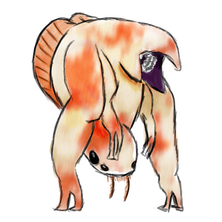
The gusano (Vermes grandezii xenos) are a species of advanced aliens that seem to have originated deep in the galactic core. Historically disunited, the various gusano states banded together against what they (not so erroneously) believed to be a threat to their very existence: the human race. The gusano, while having incurred the wrath of humanity, have yet to be wiped out, mostly due to the distraction provided by the Galactic War. Collectively, they currently pose the greatest extraterrestrial threat to mankind, and are comparable in power to the weaker great powers.
The gusano were named by the famous Coalition Admiral Grandeza, who when presented with some gusano juveniles mentioned they looked like worms, or “gusanos” in Spanish, an old Terran dialect. Mature gusano look nothing like their young, instead resembling prawns and gorillas more than their maggot-like larva. It is known that most life the gusano have xenoformed their colonies with feed on nuclear reactors and gusano juveniles nurse around these reactors to gain energy from the heat before entering a pupal stage and becoming mature gusano. Because of this, gusano worlds are littered with artificial nuclear reactors, normally without any form of shielding as the gusano suffer no ill effects from radiation levels that would kill a human. This has made terraforming gusano worlds difficult, but not impossible, as thanks to the Collapse mankind has experience in reviving irradiated worlds. The gusano’s dependence on nuclear reactors has also made them target human ships and converting them into “nurseries.” The gusano are known to prefer hot, desert environments with carbon dioxide atmospheres.
Gusano technology is very advanced, the gusano apparently using the natural nuclear reactors available to them to advance much faster in the fields of electric generation and the assumed prevalence of heavier metals in their homeworld’s crust should have helped them with metallurgy. It is known that they have developed Alkaev drives much later than mankind at a comparable point in development. The gusano have yet to master coilgun technology and energy shielding, giving mankind an advantage over them in that regard.
For reasons as of yet unknown, the gusano prefer tripods to conventional armored vehicles, and sonic and EMSEL weaponry is more prevalent. The former has been exploited ruthlessly by the human militaries, which send small fireteams with antiarmor weaponry to shoot off the tripods’ legs, forcing even the most conservative gusano polities to adopt human designs. Suicide bombers are also common among the gusano militaries, but whether this is an act of desperation or some sort of religious fanaticism is still unknown. Gusano militaries also employ what could only be described as “jetpack infantry” armed with discus-like explosives and front-line infantry armed with melee weapons (usually made out of hard, irradiated crystal shards) have been encountered on more than one occasion.
Thanks to incompatible software, barely translatable languages and constant hostility between the two, humanity is not very knowledgeable about gusano history, politics or culture. What is known is that gusano unity is a recent development and caused by mankind’s excursions into gusano space and gusano studies on other xenos that mankind has exterminated or enslaved. It is known that the gusano as a whole have a more prominent warrior culture than mankind and several gusano “nations” are extremely xenophobic to the point of shunning any objects and practices of non-gusano origin, but the most successful groups tend to be the ones that embrace human technology and combat. The largest gusano group, the Sons of Mzha, is closer to a religion than a state, but from what little human xenobiologists know the distinction is blurry.
Observations on human attacks against some gusano worlds reveal heavily irradiated altars where gusano juveniles have seemingly been sacrificed (gutted and turned inside-out, with strange markings carved into their flesh) and mass graves filled with the corpses those physiologically unable to fight against the invading humans. Piracy is also very common, with gusano raiders boarding defenseless vessels, venting the atmosphere to kill any humans inside, and flying the ship into gusano space. Torture, both of human prisoners and other gusano, by some gusano polities is well-documented and has led to a no surrender policy among invading humans. Undoubtedly, these brutal practices are not universal among the gusano, just as dictatorship is not universal among mankind, but the frequency of these findings has steeled mankind’s hatred for this new foe.
Most gusano languages do not distinguish between proper nouns and common nouns, and gusano language is spoken subsonically, so any proper nouns are mostly human constructions with at best only a tenuous connection to the actual gusano "word." As with all gusano language translations, very general concept approximations are used.
Major Gusano Factions
Like their human foes, the gusano species is not and has never been united under a single banner. Although most organized groups have at least called a ceasefire after the regular campaigns of extermination humanity has waged on the entire gusano species, these groups are far from friendly with one another and happily resumed their wars when the Galactic War began. Gusano "states" are not states in the human sense; for example, gusano states are not sovereign and are "tribal" rather than territorial or ideological in nature, but they are the nonetheless able to mobilize resources, provide security and are highest authority in gusano society so human societies tend to treat them as states.
Because the gusano reproduce by laying many eggs and hoping a few larvae survive as opposed to nurturing a few children as with humanity, gusano psychology is markedly different. On the one hand, the individual’s life is much less emphasized than in human society; sacrifice for the good of the group is first nature and inherently desirable, while human states invest a lot in making sure their subjects serve the state before themselves. On the other hand, loyalty is very tight-knit among those of the same age group and “school”; parental heritage is unimportant and artificial to the gusano while it is first nature for humans. The frequency of death, especially in childhood and early adulthood also leads to the idea that life is cheap and that whatever force exists in the universe is inherently malevolent, if it exists at all. This manifests itself differently throughout gusano society.
Sons of Mzha
A very large gusano group, the exact nature of the "Sons of Mzha" constant point of contention for human xenobiologists. From what little humans have gleaned, the group revolves around the titular “Mzha,” a powerful figure that has traits of religious figures, political leaders and "parent." (The concept of “parenthood” is a relatively recent development in gusano society, but originated before contact with mankind.) The idea seems to be most similar to the Conseil’s cult of personality, but the Mzha is also seen as a force of nature and something that is “one” with existence, but at the same time separate from the individual gusano. Whether this Mzha is an actual individual, an elite cabal going by the label, or a symbolic concept, is unknown, despite many efforts to somehow neutralize this figure.
From what is known, the Sons of Mzha directly foster an idea that “Mzha” is actively malevolent. The group regularly conducts depraved acts of torture, such as placing the larvae of a carnivorous gusano subspecies in the carapace of devotees or throwing fanatics into Vacuity portals. This is seen by both humanity and most gusano factions as horrifying (mostly because it serves no tangible purpose), but the Sons of Mzha seem to actively enjoy this display and it is clear that these acts are not committed to instill fear. Translated Mzha texts tend to have a nihilist tone, remarking that in the end all would be “consumed” by the Mzha, indicating that the Sons of Mzha do not try to curry favor with this force.
Of all the gusano factions encountered by humanity so far, the Sons of Mzha are the most willing to adopt human technology, believing that humanity is merely another force of the Mzha and would one day be consumed by it. Repurposed human technology, slapped together with the help of gusano materials, is commonly seen in the hands of the Sons of Mzha; main battle tanks captured by the Coalition from Vacuity pockets have been encountered as the hull of gusano spacecraft. Although most human states refuse trade with the Sons of Mzha, it is apparent that criminal organizations and the libertine Kassel Confederation have some business agreements with the xenos. In warfare, the Sons of Mzha are particularly ruthless and revolve around sending waves of close-combat infantry supported by suppressive weapons, but they have quickly adopted human combat doctrines. The Sons of Mzha tend to favor the use of sonic weaponry more than other gusano factions.
Ansath
Perhaps the second largest gusano faction and primary rival of the Sons of Mzha, it is clear that the Ansath were dominant in greater gusano society before its encounters with humanity. How the Ansath came to dominance outright perplexes mankind, as their ideology is extremely pacifistic and filled with many paradoxes that even other gusano groups acknowledge. It is theorized that the Ansath rose to prominence before the development of their current ideology.
Like most gusano ideologies, the Ansath are very nihilistic, preaching that there is no absolute truth but that truth is only true sometimes, but rather than accepting that this makes truth useless the Ansath have a strong belief in "making things right," similar to the Conseil concept of spreading the revolution or the old Coalition concept of crusading. How the Ansath reconcile this belief in relative truth and moral imperative depends on the individual, but most explain it as spitting in the face of nihilism and creating a truth that they would enforce throughout the stars. The Ansath believe they have a duty to “uplift” the whole of gusano society as opposed to individual "schools," even at great cost to the schools, and foolishly believed humanity would do the same. They also believe that by creating "the good", they could enforce a sort of stability and order while at the same time keeping a relativist core that changes with the preference of individuals or schools. This duty, xenobiologists explain, seems to stem from the more communal nature of gusano psychology but also from the idea that the Ansath are superior and therefore must demonstrate this superiority at all times. They also believed that gusano biology could be improved, and so advanced their bioengineering programs to create gusano “castes”; a similar system has been adopted by the Conseil Systems.
Because of this "imperative," the Ansath believed it was their duty to unite the entire gusano species under their rule and spread and enforce their "good," not for their own benefit but for that of their subjects. The Ansath were regularly conflicting with the Sons of Mzha for influence, but unlike almost every other society in the galaxy the Ansath used violence as a last, rather than first, resort. The Ansath belief seems to be that violence is primitive and "below" them. However, they were not above the use of tranquilizing drugs to "enlighten" dissidents and dissuade them from opposition by making them happy and complacent.
Economically and politically, the Ansath are dominated by the greatest thinkers in Ansath ideology (which are in truth the gusano with the most under-the-table influence). Ansath economics, like most gusano economics, is far more command-based than non-communist human economic systems, but Ansath economics diverges from almost every other society in that it produces more widely available "luxury" consumer goods as opposed to the utilitarian economies that dominate both gusano and human society.
